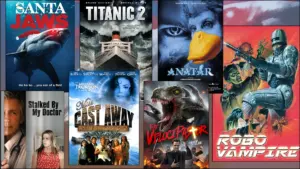An official holiday for decades before Hollywood opened shop, Thanksgiving hasn’t inspired quite the same body of movies as Christmas, or even Halloween. Those that have been made tend, in the main, not to be especially festive.
In fact, many turn on the pathology of neurosis-making encounters with family and the dark possibilities of what happens when tryptophan mixes with long-suppressed memories, which usually does not result in happy times.

Wearing her director’s toque, Jodie Foster took a nicely dark view of the season, for instance, with her 1995 film Home for the Holidays. Robert Downey Jr. was in a difficult patch during the filming, it’s said, and it shows to useful effect; there’s a reason people suffer for art. There’s a reason people suffer through dinner-table conversations, too, and some of the exchanges in this film are excruciating. Watch Foster’s worthy if glum film, and the chances are good that your own table talk will seem bright and cheery by comparison, even with that Trumpy uncle you’ve been avoiding.
Steve Martin doesn’t always mug for the camera, though you wouldn’t necessarily know it from John Hughes’s Planes, Trains and Automobiles, which is as much a road film as a buddy film and a sentimental ode to family and the holidays—even though it is all those things as well, and quite possibly the most Thanksgiving-centric film of them all.
Christopher Walken almost always plays weird, however. (For a six-degrees-of-separation moment, see Walken and Martin together in the exceedingly strange film Pennies from Heaven.) Walken had one of his finest weird moments in a just-beyond-cameo appearance in Woody Allen’s film Annie Hall, in which social worlds, cultures, and mindsets collide over a Thanksgiving meal whose every clatter of crockery and scrape of the knife is pure torture.

The mood gets even darker with Ang Lee’s majestic film The Ice Storm, set in the well-to-do Connecticut suburbs in 1973. The talk is all Watergate, the behavior all desperate efforts to be au courant (or au Hartford Courant, perhaps) with open marriage, casual drug use, and other hallmarks of the era. No one in the movie can be said to be well adjusted, but certainly anyone who was around at the time can vouch for the characters’ authenticity.
Bart Freundlich’s film The Myth of Fingerprints, similarly, puts generational talking-past-one-another and various other species of dysfunction at center stage, though without the key exchange.
Given such filmic moments, you might well wonder what there is to be thankful about this time of year. For a happier take on the holiday, there’s the affecting made-for-TV film The Thanksgiving Promise, which answers the question very nicely. (Let’s not give the plot of the film away here.)

And there’s A Charlie Brown Thanksgiving, with its ever-joyous music by Vince Guaraldi—though, a recent biographer tells us, Peanuts creator Charles Schulz was a pretty glum fellow in real life.
It could be worse, though: We could be eating our turkey in the slammer in upstate New York, the setting for the documentary Sing Sing Thanksgiving, a concert film from 1972 featuring Joan Baez, B. B. King, and Mimi Fariña.
Or we could be starving to death in the Far North, which is just as we find Charlie Chaplin in The Gold Rush. To have anything at all to eat for his Thanksgiving feast, Chaplin’s character, a starving prospector, is forced to cook up his own boot in a large pot. Cabin fever gets the better of his partner, who contrives to get the bigger portion and the choicest nails and laces. Much jollity ensues. The same film features Chaplin’s famous dancing dinner-roll scene, lest the boot leave you wanting more, as it surely will.

Finally, there’s another classic film, Casablanca. And what does it have to do with the feast? Only that the cynical, smart, funny, and endlessly problem-plagued movie debuted on Thanksgiving Day, 1942, in New York. It’s been pleasing audiences for more than 80 years now, and anyone who loves films can cite it chapter and verse. And that’s something to be thankful about.
















